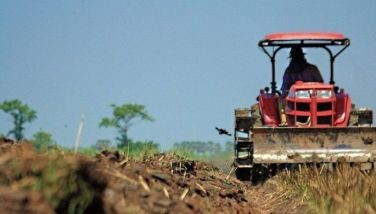Know ahead of time when the soil erodes
May 1, 2005 | 12:00am
Advanced computer simulation technology has made it easier for development planners to know the occurrence of damages, particularly those concerning the environment.
Soil erosion is one of the most threatening environmental problems plaguing upland watersheds of the country. A way to address this problem, according to experts, is to know beforehand when the soil erodes. This means predicting soil loss and sediment yield. The procedures for doing such would aid planners in developing soil conservation measures, reservoir sedimentation studies, and reservoir design.
The Water Erosion Prediction Project (WEPP) model helps address soil erosion problems. The National Soil Erosion Research Laboratory of the Agricultural Service, United States Department of Agriculture, Forest Service of the Bureau of Land Management, 10 universities in the US, and a number of international scientists developed the model. It has been proven applicable in many continents. In Asia, China has already applied this model.
In the Philippines, Victor B. Ella of the University of the Philippines Los Baños tested and demonstrated the applicability of the WEPP model for estimating and predicting soil erosion and sediment yield in selected small upland watersheds in the country.
Ella briefly describes WEPP as a process-based, continuous computer simulation model for predicting water-induced soil erosion either on a hill slope or watershed scale. It consists of nine components–climate generation, hydrology, soil physics, irrigation, plant growth, residue decomposition, hydraulics of overland flow, erosion, and even winter processes.
The traditional approach to erosion estimation in the Philippines uses the Universal Soil Loss Equation (USLE), which simulates erosion on a plot scale. WEPP is capable of simulating or predicting soil loss and sediment yield on a watershed scale. The WEPP model has addressed other limitations in USLE.
Based on the current version of the WEPP model, which is applicable only for small watersheds, Ella focused the study on the Maagnao and Tugasan sub-watersheds of the Manupali River basin in Bukidnon.
Results of the watershed-scale simulations of the WEPP model indicated that generally, increasing the percentage of cropped area in the watershed leads to an increase in sediment yield and a decrease in sediment delivery ratio.
Simulated values for stream flow and sediment discharge were higher than the observed values because some observed values were practically unaccounted for in the measurement.
The study was monitored by the Philippine Council for Agriculture, Forestry and Natural Resources Research and Development (PCARRD. — Ofelia F. Domingo, S&T Media Service
Soil erosion is one of the most threatening environmental problems plaguing upland watersheds of the country. A way to address this problem, according to experts, is to know beforehand when the soil erodes. This means predicting soil loss and sediment yield. The procedures for doing such would aid planners in developing soil conservation measures, reservoir sedimentation studies, and reservoir design.
The Water Erosion Prediction Project (WEPP) model helps address soil erosion problems. The National Soil Erosion Research Laboratory of the Agricultural Service, United States Department of Agriculture, Forest Service of the Bureau of Land Management, 10 universities in the US, and a number of international scientists developed the model. It has been proven applicable in many continents. In Asia, China has already applied this model.
In the Philippines, Victor B. Ella of the University of the Philippines Los Baños tested and demonstrated the applicability of the WEPP model for estimating and predicting soil erosion and sediment yield in selected small upland watersheds in the country.
Ella briefly describes WEPP as a process-based, continuous computer simulation model for predicting water-induced soil erosion either on a hill slope or watershed scale. It consists of nine components–climate generation, hydrology, soil physics, irrigation, plant growth, residue decomposition, hydraulics of overland flow, erosion, and even winter processes.
The traditional approach to erosion estimation in the Philippines uses the Universal Soil Loss Equation (USLE), which simulates erosion on a plot scale. WEPP is capable of simulating or predicting soil loss and sediment yield on a watershed scale. The WEPP model has addressed other limitations in USLE.
Based on the current version of the WEPP model, which is applicable only for small watersheds, Ella focused the study on the Maagnao and Tugasan sub-watersheds of the Manupali River basin in Bukidnon.
Results of the watershed-scale simulations of the WEPP model indicated that generally, increasing the percentage of cropped area in the watershed leads to an increase in sediment yield and a decrease in sediment delivery ratio.
Simulated values for stream flow and sediment discharge were higher than the observed values because some observed values were practically unaccounted for in the measurement.
The study was monitored by the Philippine Council for Agriculture, Forestry and Natural Resources Research and Development (PCARRD. — Ofelia F. Domingo, S&T Media Service
BrandSpace Articles
<
>
- Latest
Latest
Latest
March 4, 2024 - 3:32pm
By Ian Laqui | March 4, 2024 - 3:32pm
March 4, 2024 - 2:12pm
By Kristine Daguno-Bersamina | March 4, 2024 - 2:12pm
February 17, 2024 - 2:31pm
February 17, 2024 - 2:31pm
February 13, 2024 - 7:24pm
By Gaea Katreena Cabico | February 13, 2024 - 7:24pm
February 13, 2024 - 7:17pm
By Ian Laqui | February 13, 2024 - 7:17pm
Recommended



























